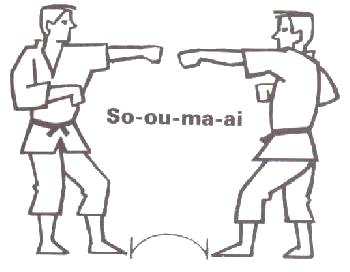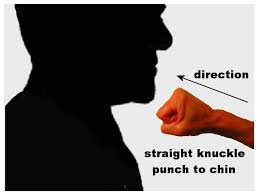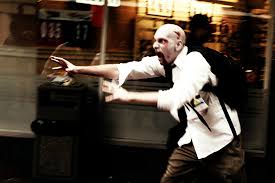These gentlemen are going through the motions of their system's kata. They are relaxed, and practicing fitting in, so they are not taking falls. It is a little lazy, but I do that too.
I have two major criticisms of this video - constant distance testing, and an attack coming from a fully extended position from too far away.
(edit) It appears that they blocked having the video embedded.
CLICK HERE FOR VIDEO
In recent years I have seen some aikido organizations move to an ever increasing more contrived system of attack, or really uke delivering energy so technique can be made.
Let's look at the video. What do we see first as the two artists come together? They measure ma-ai, or their engagement distance. They both stick their arms out to make sure they are playing at the correct distance.

Measuring ma-ai is fine every once in a while if your distance calibration is off. I strongly disagree with doing it EVERY TIME during practice after an artist reaches gokyu level. This is beginner level stuff. Rather than having to measure distance an artist should have range so ingrained into their heads they naturally move to correct ma-ai every time. These gentlemen appear to be high level artists, so really they already know ma-ai, they are just going through a dance of needless motions. Checking ma-ai every time makes practice too easy and robs the student of the most important practice that aikido training should give - a natural and automatic use of space.

The next piece of technical criticism I would like to give this practice demonstration comes right after they check for ma-ai. The Uke, or attacker, leaves his arm out. The arm is already fully extended in an attack at the range of ma-ai. This is contrived and unrealistic. When someone wishes to strike something they do not first extend their arms - then move to break space. Really the way it happens is first an attacker must break space, then the strike is initiated. By practicing the way they are doing it, they are putting artificial, non-realistic parameters on their engagement. They are able to connect to a fully extended arm far earlier then they would actually be able to ever do with a real attacker.

When a real strike truly comes in, it will coming from a very different, and often unpredictable angle. The first motion the tori does in the film is a cross body balance break. It is very easy to perform this balance break with a static, unmoving arm traveling down one line from a great distance. Almost no attack a human being does to another will replicate these circumstances. I find these method of attack to be over simplified to the point of uselessness. When one of my Senseis first saw this, he called it a "dumb downed" attack. At my dojo we call it the zombie attack, denoting the rigid arms out motion of it.

In conclusion, we must train with safe, yet realistic attacks or we will start building system of false cause and effect relationships and body dynamics. Built into our system of attacks we must train our minds to process space quickly effectively and automatically. If we over simplify the training, we begin a process of robbing ourselves of the critical skills we most need to develop. Having automatic spacing and learning to intercept an arm appropriately are some of these critical skills.
Once again, a heart felt thank you to the fellows I am doing the technical criticism of. I am sure they are wonderful artists, and could probably kick my butt.







Good post. As I've mentioned before, I don't mind the checking maai every time thing. It helps in a couple of ways - first it serves to reenforce the distance, but it also serves as a pause, sort of keeping the governor bolt on the practice so that uke doesn't just casually walk or lunge into tori. That sort of attack is ok for some forms of randori, but for practice, an attack where uke takes time to get his body organized is harder to deal with than the idiot lunge.
ReplyDeleteAs for the leaving-the-arm-straight-the-whole-time thing, that is a very basic form of the attack that gives me pause when I see it from mroe advanced players too. (and me and mine are guilty of it too) but we try to do an attack sequence that looks something like this:
- measure maai
- both partners put their arms down
- uke lunges through maai as he raises his arm(s)
- tori evades as he sees uke's center of mass starting to move
That's our basic practice mode - there's a lot of variation that can be thrown into that.
For some articles I've written about this over the years, you might be interested in checking out...
http://www.mokurendojo.com/2007/12/attacking-in-aikido.html
Great posts Parker Sensei. You are way ahead of me on the writing tip. We should compile a book someday. I see we at KyuRyu are not the only ones to use the undead reference. Its pretty obvious I guess.
ReplyDeleteI gotta say I disagree about the ma-ai testing issue though. It just looks like they are not confident and need extra time to think about what they are going to do next. I don't see most systems using ma-ai measurement in this way. It is adding in non essential movement.
We will have to settle this like men of samurai spirit - I challenge you to a BBQ off!
Nicely written piece as usual. Here's my $0.0.2:
ReplyDelete"These gentlemen are going through the motions of their system's kata. They are relaxed, and practicing fitting in, so they are not taking falls. It is a little lazy, but I do that too."
This does have the energy of a relaxed session, and is devoid of any tension in the engagement. It's like playing the notes on a sheet of music, rather than playing the music.
It's difficult to learn to throw people without throwing people. Ukemi is the thing that will save your tail in the real world most often. I've been attacked by a lot more icy sidewalks in winter than muggers.
Ukemi is also the gateway to learning the technique, especially the kuzushi (or off-balance) that occurs. Ukemi also demonstrates if tori is applying too much energy to throw.
Not taking ukemi is a little lazy, and I'm guilty as well in Aikido. I don't suffer from that in Judo at all though.
"Measuring ma-ai is fine every once in a while if your distance calibration is off. I strongly disagree with doing it EVERY TIME during practice after an artist reaches gokyu level. This is beginner level stuff."
I'd say yonkyu, but otherwise I totally agree with you. It should not be an every time deal, especially during a demonstration. Perhaps once, at the beginning, to demonstrate you can gauge distance accurately, but certainly not every time.
"Checking ma-ai every time makes practice too easy and robs the student of the most important practice that aikido training should give - a natural and automatic use of space."
You're right on the money.
"The next piece of technical criticism I would like to give this practice demonstration comes right after they check for ma-ai. The Uke, or attacker, leaves his arm out. The arm is already fully extended in an attack at the range of ma-ai. This is contrived and unrealistic."
...
"They are able to connect to a fully extended arm far earlier then they would actually be able to ever do with a real attacker."
This is a fairly common practice. Once ma-ai is measured, tori drops his hand to signal he is ready to perform the technique. As uke is already positioned, tori must respond more efficiently and faster to the penetration of ma-ai. Any sort of "get ready" action uke makes to attack affords tori a margin in time to also get ready. I think training at the edge of this envelope is useful.
"I find these method of attack to be over simplified to the point of uselessness"
While I understand your sentiment, working from a shomen-ate style attack does something fairly unique: it allows uke to practice Aikido at the same time as tori. If uke is delivering a non-Aikido attack (such as punching, chopping, etc.) he is spending half his practice time doing something other than Aikido. The consistency of this attack action also builds a constant into the learning equation. If you are encountering random events as tori, it takes longer to build skill than if practicing against a single attacking action. This consistency also makes it easy to diagnose issues with uke and tori.
"In conclusion, we must train with safe, yet realistic attacks or we will start building system of false cause and effect relationships and body dynamics. Built into our system of attacks we must train our minds to process space quickly effectively and automatically."
Agreed.
Sloan Sensei,
ReplyDeleteThe attack delivered in the way that is demonstrated on the film is not shomen ate. No where in the walking kata do we stick our arms out - then step.
I agree the uke should be doing aikido as well. Simply take the first push, or any of the pushes from the walking kata. At KyuRyu we do the shomen ate attack as our primary attack. We do it as it appears in the walk.
Upon closer inspection, I would concur with your assessment. If tori simply stood there and failed to move, it does not appear uke's attack would result in a throw.
ReplyDeleteNow I understand the "zombie attack" reference.
RE: Samurai BBQ - I'll see your BBQ and raise you a fish fry.
ReplyDeleteBesides, Texans persist in that most distressing of habits - BBQing cows. Civilized folk, like us Mississippians, know that you can only BBQ a pig. Cows and chickens are appetizers while the pig is getting done.
I do agree that at a certain point you should not be checking Maai everytime. But where do you denote where the acutal breaks from this practice should be and for what reasons..
ReplyDeleteYou know we check maai everytime in my dojo then drop arms before attacking.. but the practice is not to check for distance but rather to enfore another rule... an agreement as to what side you will be attacking from so they may actually focus on applying the principals of the specific technique instead of wondering which side it is coming from first. As well as letting me know what side they are working on so I can Lazily help out from across the dojo.
You know Pat, there's really nothing quite like a great smoked brisket. Now, don't get me wrong, I like my pork ribs & pork butts too. I think it's because most folks don't have the patience it takes to cook brisket -- pig cooks faster & is easier to do in my opinion.
ReplyDeleteHeh, I just said that to agitate Texans, who in my experience will fight to the death over the concept of BBQ beef. Heck, We'll BBQ anything that will stand still long enough - though pig IS probably favorite around here.
ReplyDeleteI think I with you and all of this. We should eventually be able to measure my instinctively over time, without the hands, but beginners need it reinforced. When we start working on higher kata and we introduce weapons, which changes the ma-ai, we might need to measure again once in a while, but I think that level of player will be able to eyeball that distance, too.
ReplyDeleteAnother nice thing about higher kata is the occasional introduction of different attacks (yokomen uchi, etc.) thought not a heckuva lot.
Shomen ate is also a lot faster an attack than most others. Most other attacks, you can see coming from a mile away, but shomen ate has a way of just coming out of nowhere. The hope is, I think, if I can deal with that, I can deal with most others. As for whether or not to keep it raised or start from neutral (at the waist) I usually have kyu grades start with it up. It's kind of like training wheels. That keeps the surprise factor down (they have a lot to think about while learning new things).
Once you've reached the dan grades (maybe even nikkyu, ikkyu) I'd say start the attack with the hand down, or even start with uke walking toward you and THEN attacking, or have both of you walking toward each other and THEN the attack happens. Things get a little more honest at that point, I find.
Hopefully, randori should (ideally) show us when and where we're cheating in kata; when we've been succeeding in kata but failing in randori, then something's amiss. But even in randori, it's easy to not REALLY commit to an attack, to be a "zombie." I've found it's very hard for most folks to pretend you're trying to kick someone's ass when you're not really wanting to kick someone's ass (something most punching/kicking arts don't have a problem with; they're padded up and ready to kick ass!) Sometimes I have to stand there and make uke push me down with shomen ate several times, before I finally do the balance break, just to reinforce an honest attack.
Anyway, great thoughts, as always! Making me think about things differently!
As for BBQ, what's the consensus on what you put ON the thing? Tomato-based sauce, vinegar-based, rubs...? (I'm as neutral as Switzerland. I'll eat it ALL.)
Re BBQ sauce - Mississippi style BBQ has to be drownded in a sauce (wet BBQ) that is heavy on the tomato, brown sugar, vinegar, and mustard.
ReplyDeleteThere's also something to be said for what uke does AFTER his initial shomen ate attack. Often, we can get pretty laconic about that, too. Sometimes, uke just walks around waiting for tori to do his thing, which is not a good habit, either...
ReplyDeleteNow I want BBQ for lunch.
what kind of uke you create will detrimine what kind of tori you wind up with -- what constitutes correct attack and correct reaction; correct ukemi, varies widely -- at its most basic any invasion of space can be attack, zombielike or not-- this said --it is correct to assert that the attack that rises directly to the face from ma-ai is technically more challenging (perhaps the most challenging given that both are in forward motion--hence preferable for better advanced/advancing reaction training) and also that consistanly working from a pre measured ma-ai before each encounter may produce unintendend dependance in tori--
ReplyDeleteon measuring ma-ai--
the question for me is how much preceptual reinforcement is required to set the unconscious trigger reflex of the eyes parralax for evasion at ma-ai? lots of reps for sure -- a thousand minimum -- probably better in the 10,000 range or somewhwere in between -- at some point the deal is done and the reflex is set, but then if it contiues, does it in fact dull reactions-- i think maybe you are right, the eye may get too depenadant on targeting off the hand at range rather than doing the more classical eye contact ma-ai function-- metsuke and ma-ai are one and if we forget it it comes back to haunt us with the distractions of hand speed